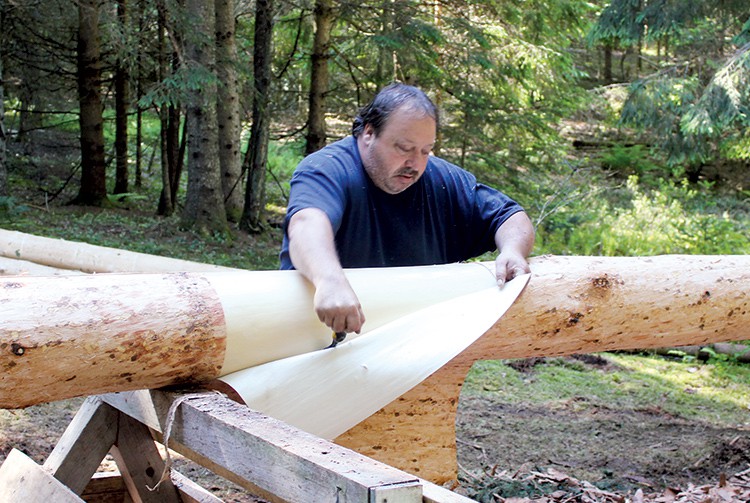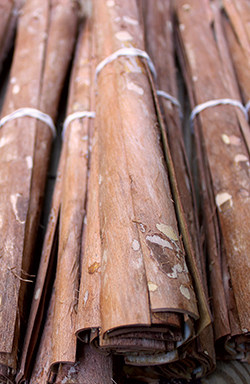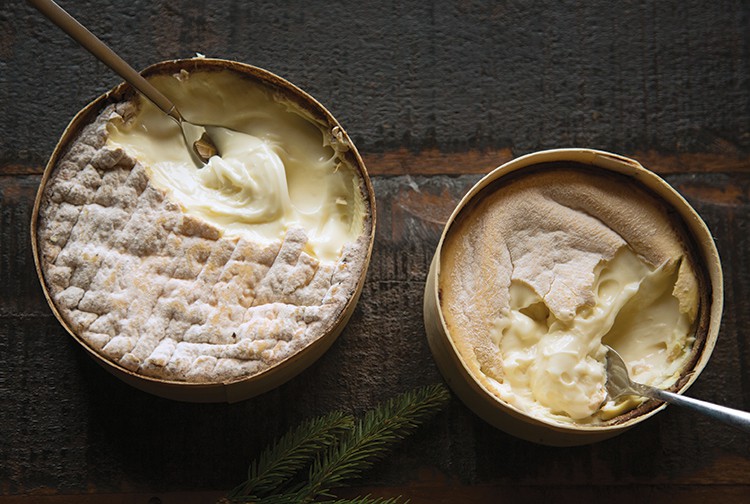
The sun is starting to poke through the trees at 7 a.m. on a June morning in Vermont’s Northeast Kingdom, where the forest air is resin scented and thick with rising dew. The sleepy town of Greensboro is just starting to stir, but Ron Hall is already hard at work. Other than a few chirping birds, the only sound in that forest is the scuff, scuff of blade against tree trunk, as he runs a two-handed bark scraper over the crusty outer surface of a freshly cut spruce.
Once he removes the felled tree’s outer layer, revealing a splotchy pink surface, Hall takes a small blade and makes a shallow, rectangular incision into the trunk. He grabs the corner of that rectangle and pulls—a layer easily peels off. This is the inner bark; it’s moist and flexible, almost like leather, and it’s been protecting the ivory-colored layer just underneath (the tree’s outermost ring of wood).
On a nearby table, Hall slices the inner bark into skinny strips, letting them dry for the rest of the day until they’re firm. Eventually, they’ll be sanitized in a pot of boiling water and regain their flexibility before being wrapped around young wheels of Harbison or Winnimere at Jasper Hill Farm. Jasper Hill makes between 1,800 and 3,600 wheels of Harbison per week, and Hall only has a few warm months to harvest; when trees go dormant in the fall and winter, that inner bark is no longer supple enough to peel off. Some days he works for 14 hours, cutting enough bark—with some help from his wife, Michelle—to wrap 1,700 rounds of cheese. “Well, that’s the life of a stripper,” he says, chuckling.
Hall’s job title would be less of a punch line if he were in the mountainous Jura region that straddles the border of France and Switzerland. There he’d call himself a sanglier: a person who harvests the inner bark, or sangle, of spruce trees to wrap around cheese. Ron’s modesty about his work for Jasper Hill—one of many odd jobs he does around town throughout the year—belies the fact that he might be the only person in the United States practicing an iconic trade that’s long shaped the traditions, forms, and flavors of one of Europe’s most adored cheese styles.

Ron Hall removes the inner layer of bark from a spruce tree.
Folklore and the Forest
“The forest is everywhere, or close, in the Jura,” wrote French geographer Antoine Gioud in a 1952 journal article. “The Jurassien countryman knows it; he derives revenue from it, he works with it often, he is attached to it, he lives in it.” No surprise that the name Jura itself comes from an old Latin word meaning “forest.”
At high altitudes these are forests of spruce, or épicéa: small, hearty trees that grow for centuries. Their wood is fine and sturdy, with compact and consistent rings, ideal for making planks to age giant wheels of the region’s most famous cheeses: Comté and Gruyère. Plank making is considered an art here, requiring a subtle understanding of the trees’ connections with seasons, weather patterns, and even the moon; bois tendre en cours, bois dur en décours (“soft wood in a waxing moon, hard wood in a waning moon”) goes an old local saying.

Ron Hall’s bark strips, cut into 14-inch pieces and dried.
For centuries, after the cows descended from communal mountain pastures in fall at the end of Comté and Gruyère season, locals put spruce to use in other ways. Village animals headed back to individual family farms, where they ate dry hay, which changed the milk composition: it was less fragrant and flowery but much fattier. Smaller cheeses made more sense—softer, creamier cheeses that could be spread or dipped into like a fondue. These early versions of now-AOP-certified Vacherin Mont d’Or (on the Swiss side) and Vacherin du Haut-Doubs (on the French side) became so soft and melty they’d need to be bound to keep their shape, lest they turned to pancakes. Naturally, that vessel was made of spruce bark, which was flexible and easy to shape.
While Andy Hatch makes cheese across the world in Wisconsin, he understands the tradition of switching to softer cheeses in wintertime. When he started working at Uplands Cheese in Dodgeville, the farm was only producing one cheese: a hard, Alpine-style called Pleasant Ridge Reserve. That style, Hatch says, has always expressed the complexity of the farm’s raw grass-fed milk perfectly; those aromas of herbs and flowers blossom over time as the cheese ages. But cows in Wisconsin can’t dine on fresh grass all year, so as soon as fall came around, Uplands would sell the milk instead of making it into cheese.
“I started thinking about the milk we sold in the fall,” Hatch says. “It’s really beautiful milk. The fat content goes way up … it wouldn’t have the same flavor complexity that the grass-fed milk would, but it has a different quality, more weight.” So he turned to France—where he’d spent time learning to make cheese—for inspiration. Following the old-world seasonal model, he created a new bark-wrapped cheese called Rush Creek Reserve, which he only makes in fall and winter. “Really, we were just trying to match the character of the fall milk to the best cheese for expressing that character,” he explains.

From left: Winnimere and Vacherin Mont d’Or
Form and Flavor
That character—that creaminess—is one of the most beloved traits of bark-wrapped cheeses. When young, disks are about the texture of a kitchen sponge, able to stand up on their own. But the superhigh moisture content comes to life after a short initial aging period. “The ripening process liquefies the proteins and makes it so runny,” says Hatch, who soaks his bark strips in a solution of yeasts and molds before binding the cheeses and washes the wheels frequently during aging. “With Rush Creek we really push the limits of liquidity, and it would be really difficult to handle that cheese without the support of the bark.” Keeping it all together, the bark makes an otherwise-oozing cheese scoopable, points out Molly Browne, Jasper Hill’s account manager and monger liaison. In that sense, she says, “the bark becomes a very important part of the structure of the cheese itself.”
Of course, cheese has an uncanny ability to take on aromas from its surrounding environment, and there’s no doubt that woodsy flavors get pulled into the mix. French and Swiss researchers examining the volatile compounds present in Mont d’Or–style bark-wrapped cheeses have found noticeable increases in terpenoid compounds, such as evergreen-scented pinene and citrusy-sweet limonene—the same fresh aromas that characterize hops and cannabis. Spruce bark is also rich in tannins, which can contribute welcome astringency and bitterness.

From top: Extrabrebis and L’Edel de Cléron
Spruce flavors are more pronounced when a wheel of Harbison or Winnimere is young, says Zoe Brickley, sales and marketing manager at Jasper Hill Farm. “It’s really pitchy and almost tannic, and just sprucey,” she says. But as the cheeses age, developing distinctive characters and pungent aromas, new flavor combinations result. “I think those aroma compounds [in the spruce bark] get metabolized and mix with what’s happening in the cheese.” In pasteurized, smaller-format Harbison, the spruce comes through in the cheese’s mustard notes, while in larger, raw-milk Winnimere, it hints at smoked ham.
Andy Hatch picks up that smokiness in his Rush Creek Reserve, too. “Combined with the savory flavors of the cheese, the bark gives it that ham- bacon [taste],” he says.
Molly Browne from Jasper Hill finds those rustic, woodsy flavors come as a surprise to first-time tasters. “People always say, ‘I’ve never tasted cheese like this, what is this?’”
And with the combination of spoonable texture and aromatic flavor, it’s easy for newcomers to get hooked. These days more and more makers are adopting bark wrapping, experimenting beyond the AOP-certified versions with different milk types, new shapes and sizes, and new rinds; take, for example, white and fuzzy goat’s milk Chèvre Sanglé, or oval-shaped sheep’s milk Le Lou Claousou. While non-AOP versions can be made year-round, some—such as Jasper Hill’s Winnimere and Uplands Cheese’s Rush Creek Reserve—respect the practice of using only fall and winter milk. Much like the Mont d’Or in Switzerland, these cheeses have developed a cult following; they mark the change of the seasons and hint at Thanksgiving and Christmas feasts to come. It’s no wonder people line up to get their hands on them.
So for now, at least, Jasper Hill’s Ron Hall has plenty to do. While he didn’t grow up harvesting bark like a Jurassien forest-dwelling sanglier, he’s developed a subtle sense of the inner workings of the tree. Standing in the Northeast Kingdom forest, he runs his hands over the trunk, pointing out the tricolor composition: dark, crusty outer bark; pink, splotchy inner bark; and white wood still glistening with water. “It’s pretty interesting, isn’t it?” he muses during a pause, before scraping and slicing the hot summer day away.

Humming Bark
A spruce-wrapped cheese lives up to its full potential when warm and melty. Take it out of the fridge at least an hour before serving, and let it come to room temperature. Don’t cut it into wedges or remove its bark exterior; instead, dig in from the top. Gently removing the top rind with a knife is optional (leave it on to amp up the funky flavors). Another option, especially for Vacherin Mont d’Or and Vacherin du Haut-Doubs: Wrap the wheel in aluminum foil and place in a warm oven for 15 minutes—or a few minutes in a campfire—before dipping in steamed potatoes or bread, fondue style.

Winnimere
Tasting Notes:
Chèvre Sanglé
- Fromagerie Moléson
- Orsonnens, Switzerland
- Pasteurized goat’s milk
Unlike its cow’s milk counterparts, this little goat’s milk disk doesn’t get oozy at room temperature; instead, the paste is rubbery with little holes. Lemon-frosting aromas up front give way to a tangy, acidic finish.
L’Edel de Cléron
- Fromagerie Jean Perrin
- Cléron, France
- Pasteurized cow’s milk
This superspoonable cheese is light and approachable, with a buttery flavor that dissipates quickly on the palate, leaving behind notes of green tea ice cream and cookie batter. The diminutive size (think hockey puck) allows the spruce aromas to seep well into its center.
Extrabrebis
- Fromagerie de la Durance
- Guillestre, France
- Raw sheep’s milk
The orange, speckled washed rind of this sheep’s milk wheel from the French Alps has a slightly crunchy mouthfeel, while vegetal flavors of Brussels sprouts and green onion dominate in the mouth-coating paste.
Harbison
- Jasper Hill Farm
- Greensboro, Vt.
- Pasteurized cow’s milk
White and fuzzy on the outside with a butter-colored paste, Harbison exudes vegetal aromas—notes of onions and broccoli—with distinctively bright and mustardy flavors in the mouth.
Humming Bark
- Carrigbyrne Farmhouse Cheese
- Adamstown, Ireland
- Pasteurized cow’s milk
Smelling of hard cider, resin, and sap, this small cheese from Ireland has a golden paste and a soft washed rind. The flavor is balanced and bright, with smokier notes toward its bark-wrapped exterior.
Le Lou Claousou
- Fromagerie du Fedou
- Lozère, France
- Raw sheep’s milk
This awesomely pungent, oval-shaped washed rind is made from raw sheep’s milk at a family-run farm in the south of France. It’s meaty and thick, with deep notes of straw and a sheepy kick at the finish.
Rush Creek Reserve
- Uplands Cheese
- Dodgeville, Wis.
- Raw cow’s milk
This cheese, with its rippling pink surface lightly dusted with white, is positively striking. Rich, salty, and savory, flavors of smoked and cured meat dominate, with notes of sour cream and grass in the background.
Vacherin du Haut-Doubs AOP
- Various
- Franche-Comté, France
- Raw cow’s milk
The odors exuding from this traditional cheese, made in fall and winter on the French side of the Jura, are deceivingly strong; in the mouth, it’s more delicate, tasting of fresh cream with just a hint of salt.
Vacherin Mont d’Or AOP
- Various
- Vaud and Fribourg, Switzerland
- Raw or pasteurized cow’s milk
This is the classic Swiss bark-wrapped cheese. It has a distinctive red- orange, satiny-smooth, undulating surface covering a dense and deep base of yellowy, fondantlike paste and aromas of hazelnut, spruce resin, and flowers.
Winnimere
- Jasper Hill Farm
- Greensboro, Vt.
- Raw cow’s milk
Wheels of this raw, spruce-wrapped beauty boast multilayered complexity, with grassy, almondy, and woodsy aromas mingling with savory smoked ham.



